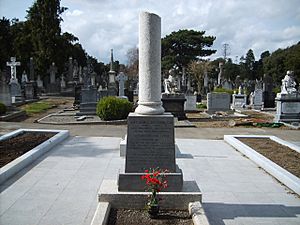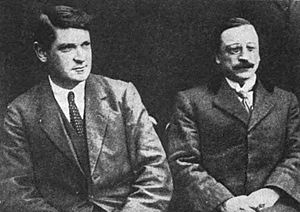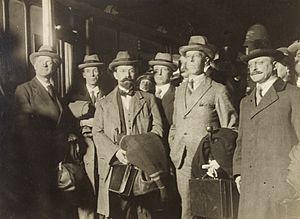Arthur Griffith facts for kids
Quick facts for kids
Arthur Griffith
|
|
|---|---|
 |
|
| President of Dáil Éireann | |
| In office 10 January – 12 August 1922 |
|
| Preceded by | Éamon de Valera |
| Succeeded by | W. T. Cosgrave |
| Minister for Foreign Affairs | |
| In office 26 July 1922 – 12 August 1922 |
|
| President | Michael Collins |
| Preceded by | George Gavan Duffy |
| Succeeded by | Michael Hayes |
| In office 26 August 1921 – 9 January 1922 |
|
| President | Éamon de Valera |
| Preceded by | George Noble Plunkett |
| Succeeded by | George Gavan Duffy |
| Minister for Home Affairs | |
| In office 2 April 1919 – 12 August 1921 |
|
| President | Éamon de Valera |
| Preceded by | Michael Collins |
| Succeeded by | Austin Stack |
| Deputy Leader of Sinn Féin | |
| In office 6 June 1917 – 9 January 1922 |
|
| Leader | Éamon de Valera |
| Preceded by | Thomas Kelly |
| Succeeded by | Kathleen Lynn |
| In office 20 May 1905 – 11 January 1911 |
|
| Leader | Edward Martyn |
| Preceded by | New office |
| Succeeded by | Jennie Wyse Power |
| Leader of Sinn Féin | |
| In office 11 January 1911 – 6 June 1917 |
|
| Deputy | Jennie Wyse Power Thomas Kelly |
| Preceded by | John Sweetman |
| Succeeded by | Éamon de Valera |
| Teachta Dála | |
| In office May 1921 – 12 August 1922 |
|
| Constituency | Cavan |
| In office June 1918 – May 1921 |
|
| Constituency | East Cavan |
| Member of Parliament | |
| In office 14 December 1918 – 12 August 1922 |
|
| Preceded by | New office |
| Succeeded by | Vacant, then constituency abolished |
| Constituency | North West Tyrone |
| In office 20 June 1918 – 12 August 1922 |
|
| Preceded by | Samuel Young |
| Succeeded by | Vacant, then constituency abolished |
| Constituency | East Cavan |
| Member of the Northern Ireland Parliament | |
| In office 24 May 1921 – 12 August 1922 |
|
| Preceded by | New office |
| Succeeded by | Edward Archdale |
| Constituency | Fermanagh and Tyrone |
| Personal details | |
| Born | 31 March 1871 Dublin, Ireland |
| Died | 12 August 1922 (aged 51) Dublin, Ireland |
| Cause of death | Intracerebral hemorrhage and heart failure |
| Resting place | Glasnevin Cemetery, Dublin, Ireland |
| Political party | Sinn Féin |
| Spouse |
Maud Sheehan
(m. 1910) |
| Children | 2 |
Arthur Joseph Griffith (Irish: Art Seosamh Ó Gríobhtha; born 31 March 1871 – died 12 August 1922) was an important Irish writer, newspaper editor, and politician. He is best known for founding the political party Sinn Féin. He led the Irish group that negotiated the 1921 Anglo-Irish Treaty. After the treaty, he served as the president of Dáil Éireann (the Irish parliament) from January 1922 until his death in August of the same year.
After spending some time in South Africa, Griffith started and edited an Irish nationalist newspaper called The United Irishman in 1899. In 1904, he wrote a book called The Resurrection of Hungary: A Parallel for Ireland. In this book, he suggested that Irish politicians should leave the Parliament of the United Kingdom in London. Instead, they should create their own government in Ireland. This idea became known as Sinn Féin, which means "ourselves" in Irish.
On 28 November 1905, Griffith officially presented his "Sinn Féin Policy." This date is seen as the founding day of the Sinn Féin party. Griffith became the president of Sinn Féin in 1911, but at that time, it was still a small group.
Contents
Early Life and Ideas
Arthur Joseph Griffith was born in Dublin, Ireland, on 31 March 1871. He was educated by the Congregation of Christian Brothers. For a while, he worked as a printer. He then joined the Gaelic League, which worked to bring back the Irish language.
His father was also a printer for a newspaper called The Nation. Young Griffith was a member of the Irish Republican Brotherhood (IRB), a secret group working for Irish independence. He visited South Africa from 1896 to 1898. There, he supported the Boers in their fight against British expansion.
In 1899, Griffith returned to Dublin and co-founded the United Irishman newspaper. In 1910, he married Maud Sheehan, and they had two children. Griffith strongly criticized the Irish Parliamentary Party for working with the British Liberal Party. He also supported movements for independence in places like Egypt and India.
In September 1900, he started an organization called Cumann na nGaedheal ("Society of the Gaels"). This group aimed to bring together different nationalist and separatist groups. In 1903, he created the National Council to protest against the visit of King Edward VII to Ireland. In 1907, these groups joined to form what became Sinn Féin.
Founding Sinn Féin
Most historians agree that Sinn Féin was founded on 28 November 1905. This was when Griffith first introduced his "Sinn Féin Policy." Griffith believed that the Act of Union 1800, which joined Great Britain and Ireland, was illegal. He argued that Ireland should be a separate kingdom, linked to Great Britain only by a shared monarch. This idea was called a dual monarchy.
Griffith's main idea for Sinn Féin was called "abstentionism." This meant that Irish politicians elected to the British Parliament should refuse to go to Westminster. Instead, they should set up their own Irish parliament in Dublin.
Griffith also believed in economic nationalism. He thought that a strong sense of national identity was important for a country's economy to grow.
In 1911, Griffith helped create the Proportional Representation Society of Ireland. He believed that proportional representation (a way of voting) would help reduce conflict between different groups in an independent Ireland.
The Easter Rising and War of Independence
In 1916, a rebellion known as the Easter Rising took place in Dublin. Even though Sinn Féin had little to do with it, the British government and media often called it the "Sinn Féin rebellion." Griffith was arrested after the Rising, even though he hadn't taken part.
When the leaders of the rebellion were released from prison in 1917, many joined Sinn Féin. They wanted to achieve a fully independent Irish Republic. This led to disagreements within the party. Griffith had supported a dual monarchy, while the new members, led by Éamon de Valera, wanted a republic.
At the party's meeting (Ardfheis) in October 1917, they reached a compromise. They decided to work for a republic first. Griffith then stepped down as president of Sinn Féin, and de Valera took his place. Griffith became vice-president.
In May 1918, Griffith was arrested again, along with de Valera and many other Sinn Féin members. This was based on a false story about a "German Plot." Griffith was in prison for ten months. While he was in prison, he was elected as an MP for East Cavan in June 1918.
In the 1918 Irish general election, Sinn Féin won a huge victory. Instead of going to the British Parliament, Sinn Féin's elected members set up their own Irish parliament, called Dáil Éireann. They then declared Ireland independent. This led to the Irish War of Independence.
In the Dáil, Griffith served as Minister for Home Affairs from 1919 to 1921. He was also Minister for Foreign Affairs from 1921 to 1922. While de Valera was in the United States (1919–21), Griffith acted as President. He was arrested again in November 1920 and spent seven months in Mountjoy Prison. He was released in June 1921 as peace talks began.
In May 1921, Griffith was elected for Cavan and Fermanagh and Tyrone. In August 1921, he became the Minister for Foreign Affairs in the new Irish government.
Negotiating the Treaty and Death
In September 1921, de Valera asked Griffith to lead the Irish group to negotiate a treaty with the British government in London. After almost two months of talks, Griffith and the other delegates signed the Anglo-Irish Treaty on 6 December 1921. This treaty created the Irish Free State, but it was not a full republic.
This decision caused a big split in the Dáil. The Treaty was approved by a close vote of 64 to 57. After this, de Valera resigned as president. Griffith was then elected to replace him as President of Dáil Éireann. The disagreements over the Treaty led to the Irish Civil War.

Griffith was very tired and stressed from the long negotiations and setting up the new government. He died suddenly on 12 August 1922, at the age of 51. Doctors said he died from a cerebral hemorrhage (a type of stroke) and heart failure. His death happened just ten days before Michael Collins was killed in an ambush. Griffith was buried in Glasnevin Cemetery in Dublin.
His Legacy
Historians note that Arthur Griffith was sometimes forgotten in Irish history, even though he founded Sinn Féin. His wife had to ask his former colleagues for financial help after his death.
Several places in Dublin are named after him, including Griffith Barracks (now Griffith College Dublin), Griffith Avenue, and Griffith Park. An obelisk (a tall, thin monument) was put up in 1950 at Leinster House to remember Griffith, Michael Collins, and Kevin O'Higgins.
Views on Jewish People
Early in his career, as editor of United Irishman, Griffith published some articles that showed prejudice against Jewish people. For example, in 1899, he wrote about a legal case in France, defending the conviction of a Jewish man and making negative comments about Jewish people and the press. He also expressed concerns about Jewish capitalists.
In 1904, his paper supported the Limerick boycott, which was a boycott of Jewish businesses. The paper claimed the boycott was against "usurers" (people who lend money at high interest), not against Jewish people specifically. However, the Jewish community in Limerick was not heavily involved in money-lending.
It's important to note that Griffith's views changed over time. From 1904 until his death, he wrote almost nothing that could be seen as prejudiced against Jewish people. In 1903, he supported a Jewish candidate for election in Dublin. In 1909, he wrote positively about the contributions of Jewish people to European culture. In 1915, he defended Jewish people against claims that they should not hold public office. His publications also showed sympathy for Jewish victims of violence in Eastern Europe.
Griffith had several close Jewish friends, including Michael Noyk, a lawyer who defended many Irish Republican Army (IRA) members during the Irish War of Independence. Noyk and other Jewish friends even bought a house for Griffith when he got married. These friendships show a clear shift in his perspective.
Error: no page names specified (help). In Spanish: Arthur Griffith para niños
In Spanish: Arthur Griffith para niños





